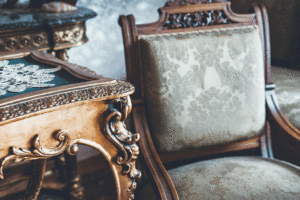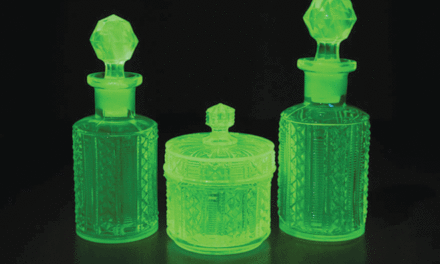
There are several types of very popular wood grains you can readily indentify if you know what to look for in eyeing your piece. Things such as grain, length of lines, knots, softness and color can help you identify types of species.
You come across a beautiful table out in an antique store.
It has a nice, dark hue to it, and it matches your chairs perfectly, but what type of wood is it? How do you determine how much it is worth and if it is even real wood?
There are many ways to look at a piece of furniture and determine from what type of wood it is made, or if it is even real wood at all.
The first thing to do when you look at a piece of furniture that you are investigating is to look at the end grain, or the edge of the piece, like the end of a drawer, or the bottom of the piece. You have several choices for what your piece is made out of, including veneer, laminate, plastic, pressed wood or the real thing.
Veneer is a large panel that is repeating in the grain pattern. A very thin layer of real wood is peeled from the tree and then attached to a sub-board of wood. It is rotary-sliced and shaved, fitting onto another board going in the opposite direction.
When peeled apart, it often resembles a peeling onion. Often times the outer layer of veneer is a better wood than the substrate.
Laminate and pseudo-wood products are pieces of wood that are made to look like wood, but are made of man-made materials such as plastic or particle board, which is bits of leftover wood or sawdust mixed with other materials, ground up, and pressed into a board, covered with a plastic coating or other material that is made to look like real wood.
Sometimes, in cheaper versions, you can literally peel off the layer of plastic, exposing particle board underneath.
Once you have determined that your wooden piece of furniture is real, you will want to determine what type of wood and from what type of tree your piece was made. There are hundreds of tree species in the world, and often times it takes an expert to determine what type of wood was used. There are several ways to help decide a mystery wood.
Look at the region your piece is from in the world. Was in made locally? Some woods are hard to find and may only be procured in certain areas. What size is your piece? Some species of trees are small, so if you have a large plank, it narrows down the type of tree that is used. What color is your piece? Woods have certain hues, textures, size, shape and direction of grain. All of these factors are used in indentification of wood types. Wood darkens, generally, over time as well, making it even more difficult to determine type. Sometimes wood is filed away or sanded in a hidden area to get a better idea of grain and color due to darkening.
There are several types of very popular wood grains you can readily indentify if you know what to look for in eyeing your piece.
Things such as grain, length of lines, knots, softness and color can help you identify types of species.
Pine is a very popular type of wood. Known for being soft, you can often cause a dent in pine with your fingernail. Pine has tell-tale rings in it, and takes on a yellowish hue.
It is the most abundant type of wood in North America, and there are dozens of species.
Oak is another common wood type. It has a more red hue with straight lines running through the grain and smaller knots, sometimes with no knots at all. There is red and white oak, and oak has a distinctive line structure running perpendicular to growth knots, which gives it an unusual pattern.
Maple is a creamy color when it is harvested, and it has a more wavy grain pattern. It is a soft wood and a hard wood (the hard wood version comes from the sugar maple tree), and it is used in making musical instruments because the wavy grain pattern can often be beautiful.
Walnut is also known as black walnut and is a dark, heavy wood. It doesn’t yield as much wood as some of the larger species of trees, and because of this, it tends to be more expensive. Black walnut is dark, has straight grain, and ranges in color from dark tan to deep chocolate.
It even has streaks of green or purple in it. The growth rings are darker in color than the rest of the grain, but not as dark as pine.
Cherry is also known as black cherry. It is identified by its reddish tones, with pink hues and reddish brown hues when exposed to sunlight. It has a straight grain with some indication of growth rings. Cherry wood is used in cabinetry because it is not effected very much by humidity due to its hardness and straight grain.
Mahogany is a hardwood and it is reddish to brownish in color. Mahogany’s grain is fine and long, and it has a slight wave to it.
If you look closely at the grain, you can see many fine dark lines going with the grain. These lines can be anywhere from 1/16 to 1 inch long.
Take your fingernail and press it into the wood-if it doesn’t dent, it might be mahogany if it fits all of the other characteristics.
Investigating your potential purchase and doing some research on wood grains and types can definitely help you determine what type of wood your furniture and future investment is made from and what the worth point on the piece can be.
Given that there are hundreds of species of trees in the world, a little investigation can go a long way into helping you determine what type of wood you may own and how to care for it and keep it for years to come.
(Editor’s note: DeeDee Wood is the store manager at Tharpe Antiques, in Easton, part of the Talbot Historical Society.)




